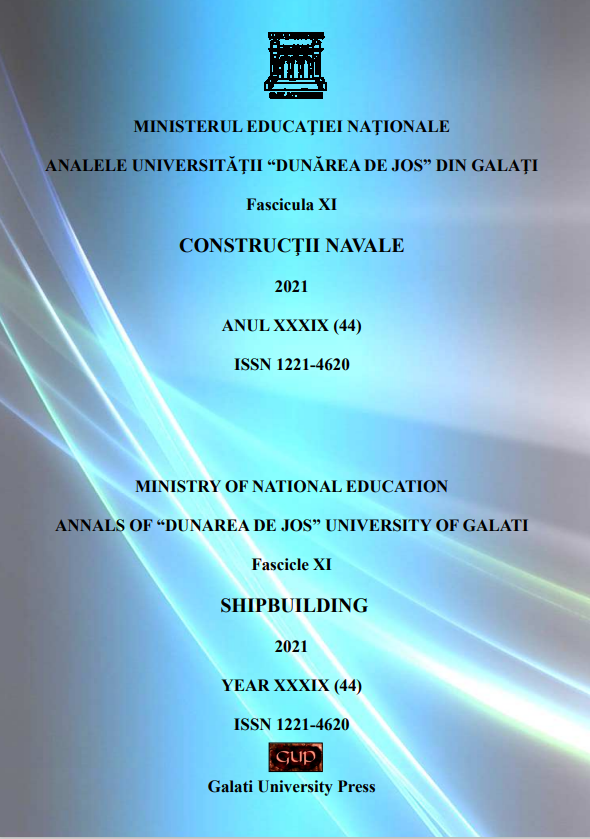Deformations on the ship blocks during fabrication: cause and remedies
Abstract
During fabrication process, material deformations are likely to occur due to various factors such as heat during steel cutting, welding induced deformations, lifting and turning of ship sections, temporary stiffening and other possible modifications of ship sections. Lifting induced deformations is one of the major causes of deformations that highly affect the production cost and quality. The aim of this thesis is to outline the main causes of deformations that occur in ship sections during fabrication and to analyse in detail the lifting and turning operations of one ship section using the Finite Element Method (FEM). A strength check using the FEM has been performed on the selected ship section to investigate the deformations and stresses in two different cases with three different loading conditions. First, the section has been analysed without temporary stiffening in three load scenarios: lifting before turning, worst-case scenario during turning and lifting after turning. Similarly, the second case study has been analysed but with the temporary stiffening added according to the lifting plan. Various influencing parameters that determine the lifting plan has been investigated such as the sling angle which directly affects the deformation characteristics. It is observed that the addition of temporary stiffening is essential to minimize the deformations and to maintain the stress levels below the yield point.
Downloads
References
[2]. Azad, N., Iranmanesh, M., & Rahmati Darvazi, A. (2020). A study on the effect of welding sequence on welding distortion in ship deck structure. Ships and Offshore Structures, 15(4), 355–367. https://doi.org/10.1080/17445302.2019.1619898
[3]. Batista, H. S. (2012). Analysis and prediction of welding deformations of ship panels in prefabrication process. Master thesis. University of Technology, Szczecin.
[4]. BV. (2020). PART B-Hull and Stability Rules for the Classification of Steel Ships. https://marine-offshore.bureauveritas.com/bv-rules
[5]. Chun, D.-H., Roh, M.-I., Ham, S.-H., & Lee, H.-W. (2018). A Study on the Methods for Finding Initial Equilibrium Position of a Lifting Block for the Safe Erection. Journal of the Society of Naval Architects of Korea, 55(4), 297–305. https://doi.org/10.3744/snak.2018.55.4.297
[6]. Damen Shipyards Galati report. (n.d.). Transport, handling and manoeuvring of various materials, pieces, structures, aggregates and equipment in storages, shops and at ships.
[7]. DNV GL. (2015). CLASS GUIDELINE Finite element analysis. http://www.dnvgl.com,
[8]. DNV GL. (2018). RULES FOR CLASSIFICATION Ships. http://www.dnvgl.com,
[9]. Galatanu, L., Gavan, E., & Georgiana DARIE, A. (2020). Stress and strain analysis that occurs in the structure of a section and in its lifting installation, during the lifting and turning maneuvers.
[10]. Hammad, A., Abdel-Nasser, Y., & Shama, M. (2021). Rational Design of T-Girders via Finite Element Method. Journal of Marine Science and Application, 20(2), 302–316. https://doi.org/10.1007/s11804-021-00206-1
[11]. Hammad, A., Churiaque, C., Sánchez-Amaya, J. M., & Abdel-Nasser, Y. (2021). Experimental and numerical investigation of hybrid laser arc welding process and the influence of welding sequence on the manufacture of stiffened flat panels. Journal of Manufacturing Processes, 61, 527–538. https://doi.org/10.1016/j.jmapro.2020.11.040
[12]. https://www.makeitfrom.com/material-properties/EN-1.0308-E235-Non-Alloy-Steel. (2020).
[13]. Jang, C. D., Lee, C. H., & Ko, D. E. (2002). Prediction of welding deformations of stiOEened panels. 36
[14]. Lee, H., Roh, M. il, & Ham, S. H. (2016). Block turnover simulation considering the interferences between the block and wire ropes in shipbuilding. Automation in Construction, 67, 60–75. https://doi.org/10.1016/j.autcon.2016.03.013
[15]. Li Rui, Zhang Fan, Liu Yujun, & Jiang Fumao. (2013). Design system for ship block lifting with Computer-aided. China Academic Journals Electronic Publishing House. 9. 3.
[16]. Mandal, N. R. (2017). Ship Construction and Welding. Springer Series on Naval Architecture, Marine Engineering, Shipbuilding and Shipping 2.
[17]. Petri Mehto. (2019). Optimized analysis method for hoisting design of large steel structures. Bachelor´s thesis. Turku university of applied sciences.
[18]. PLM Software, S. (n.d.). Femap Assembly Modelling white paper. www.siemens.com/plm
[19]. Ponthot, J. P. (2020). AN INTRODUCTION TO THE FINITE ELEMENT METHOD 1.
[20]. Samin. CO. (2013). Dimensional control for shipbuilding and marine(Online). Available from: https://www.youtube.com/watch?v=Tk27BSv7B-k.
[21]. Wang, J., Rashed, S., Murakawa, H., & Luo, Y. (2013). Numerical prediction and mitigation of out-of-plane welding distortion in ship panel structure by elastic FE analysis. Marine Structures, 34, 135–155. https://doi.org/10.1016/j.marstruc.2013.09.003
[22]. Wang, J., Yi, B., & Zhou, H. (2018). Framework of computational approach based on inherent deformation for welding buckling investigation during fabrication of lightweight ship panel. Ocean Engineering, 157, 202–210. https://doi.org/10.1016/j.oceaneng.2018.03.057
[23]. Wang, J., Yuan, H., Ma, N., & Murakawa, H. (2016). Recent research on welding distortion prediction in thin plate fabrication by means of elastic FE computation. Marine Structures, 47, 42–59. https://doi.org/10.1016/j.marstruc.2016.02.004
[24]. Yi, M. S., Lee, D. H., Lee, H. H., & Paik, J. K. (2020). Direct measurements and numerical predictions of welding-induced initial deformations in a full-scale steel stiffened plate structure. Thin-Walled Structures, 153.




